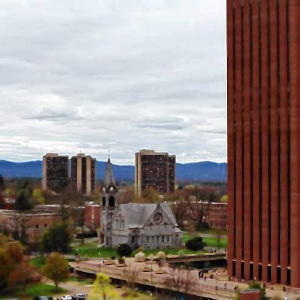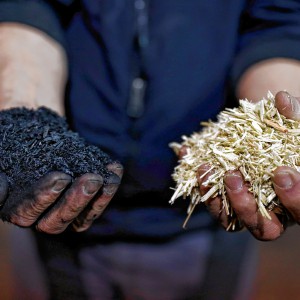Environment: Monitoring the box turtle in Amherst
| Published: 07-16-2019 3:50 PM |
AMHERST — At 4-8 inches long, box turtles aren’t easy to spot, yet Julie Miller and her son, August, found two such turtles earlier this month during hikes in the Plum Brook Conservation Area.
Then last week, August spotted a tiny turtle hatchling among the leaves while the two were on another walk. The Millers recognized the hatchling as a member of the box turtle species, like the two adult box turtles they found earlier. Those adult turtles had small rectangular monitors attached to their shells.
Curious, the Millers snapped a picture of the hatchling and sent it to the Gazette.
It turns out that two conservation biologists, Liz Willey and Patrick Roberts, are researching Eastern box turtles at the Plum Springs Conservation Area, with permission from the Amherst Conservation Commission.
Roberts said he and Willey are tracking turtles that Willey observed and marked with monitors about 10 years ago to monitor behavioral changes based on environmental changes.
“Some of these turtles seem to be using the exact same resources because the habitat hasn’t changed as much,” he said. However, Roberts warned that box turtles are still threatened by poaching, land development and roads.
“Low mortality rates can have a big impact on these populations,” said Roberts. Because new turtles do not frequently join the box turtle population in Amherst, losing just a few adult turtles can be harmful.
Article continues after...
Yesterday's Most Read Articles
In Massachusetts, the box turtle is most common on Cape Cod, on the north shore and in the Connecticut River Valley. Box turtles, native to the eastern United States, burrow under decomposing leaves or soak in shallow water to keep cool throughout the summer.
The box turtle is listed as a species of special concern under the Massachusetts Endangered Species Act, meaning the population has experienced a decline that could threaten the species if it continues unchecked. According to MassWildlife’s Natural Heritage & Endangered Species Program, some threats include habitat destruction due to land development, road mortality, mowing of grassy fields and the disturbance of nesting sites by ATVs.
A study conducted from 2005-2006 in Massachusetts by Willey and conservation biologist Paul Sievert found that the highest rates of nest destruction were at a site surrounded by residential and agricultural development. Lowest rates were at heavily forested areas where there are few other turtle species besides the box turtle.
Roberts ultimately hopes that developing a “basic understanding of how these turtles move through the landscape over time” will better inform land protection practices in areas turtles inhabit.

 Federal probe targets UMass response to anti-Arab incidents
Federal probe targets UMass response to anti-Arab incidents Locking up carbon for good: Easthampton inventor’s CO2 removal system turns biomass into biochar
Locking up carbon for good: Easthampton inventor’s CO2 removal system turns biomass into biochar William Strickland, a longtime civil rights activist, scholar and friend of Malcolm X, has died
William Strickland, a longtime civil rights activist, scholar and friend of Malcolm X, has died Advancing water treatment: UMass startup Elateq Inc. wins state grant to deploy new technology
Advancing water treatment: UMass startup Elateq Inc. wins state grant to deploy new technology
